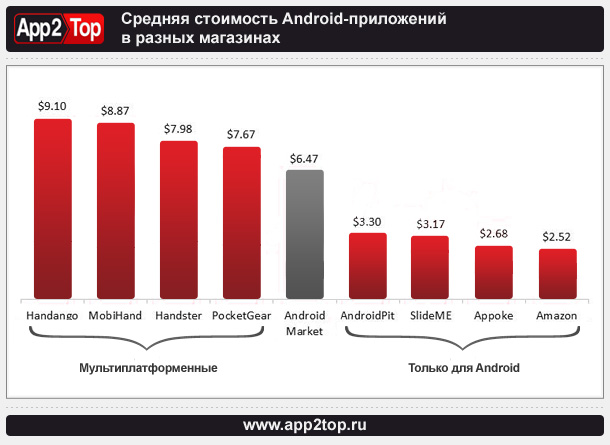How to choose an application distribution model
 According to which model is it better to distribute the application? This question has to be answered by everyone who has it. What to choose: freemium, lite+paid or only paid model? And what price should I set if it is a paid application? To choose, you need to understand how different stores differ, and what preferences their customers have.
According to which model is it better to distribute the application? This question has to be answered by everyone who has it. What to choose: freemium, lite+paid or only paid model? And what price should I set if it is a paid application? To choose, you need to understand how different stores differ, and what preferences their customers have.
Different pricing policies of storesA study by research2guidance showed that independent stores have applications with a significantly higher price than, for example, in telecom operator stores.
Developers take advantage of the fact that customers in such stores tend to spend more.
There are two main types of independent stores:
1) multiplatform storesThey can host applications for major mobile platforms, including Android, BlackBerry, Symbian, Windows Mobile, etc. Some of these stores were opened more than 10 years ago, and then there were practically no free applications in them, applications could cost up to $ 20.
According to the results of the study, the idea of paying for content is close to the buyers of such stores, and the stores themselves pay great attention to working on increasing monetization methods; as a rule, they offer more opportunities for promoting applications than mobile operator stores.
2) stores for individual platforms – niche stores that distribute applications for only one platform
These stores appeared relatively recently – about two or three years ago, after the appearance of the Apple App Store. There are many developers and users in such stores who are used to frequent app reviews and discussions. It is advantageous for developers to publish in such stores – this allows them to promote their applications faster, to convey information about them to as many users as possible, who, in turn, are looking for the most interesting and often cheaper applications. In such stores, the average price for top-end applications is much lower than in the stores of the first type.
Android App StoresIf we compare the average price for the most popular Android apps in different stores, then in multiplatform stores it will be much higher compared to the same Android Market, where users are generally less inclined to spend money.
Interestingly, the average cost of paid apps from the Top 100 in the Android Market is about 2 times higher than the average price across the market: $6.47 versus $3.07, respectively, in June 2011. This suggests that users are still willing to pay for quality.
Developers need to know user habitsAlso, when determining the price, it is extremely important to take into account the category in which the application will be sold.
For example, in the Android Market, users will not want to pay $1.5 for a ringtone, while they will willingly buy a good book for $4. Moreover, in independent stores, buyers are willing to pay even $11.56 for a book bestseller. It is necessary to carefully study the habits of users who make purchases of applications of different categories.
Business models can be differentAnd don’t forget that the distribution model may be different in different app stores: it all depends on the behavior of their customers.
In some stores, the free model works better, in others discounts and advertising give the greatest effect, while there are stores with very high quality content that is successfully sold at a high price.
